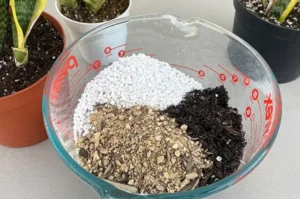Snake plants, also known as Sansevieria, are a popular choice for indoor greenery enthusiasts due to their resilience and low maintenance requirements. These hardy succulents can thrive in various conditions, but one crucial aspect of caring for them is knowing when and how to water them properly. In this guide, we’ll explore the best practices for watering your snake plant to ensure its health and longevity.
How Do I Determine When My Snake Plant Needs Water?
One of the most common questions among plant enthusiasts is how to determine when to water their snake plant. Because they are succulents, snake plants store water in their leaves. This means they can handle periods of dryness much better than being overwatered. Here are ways to tell if your plant is thirsty:
- Feel the soil: The most reliable way to know if your snake plant needs water is to stick your finger an inch or two into its soil. If it feels completely dry, it’s time to water. If there’s any moisture, hold off for a few days.
- The Leaf Check: Plump, firm leaves mean the plant is well-hydrated. If they become slightly wrinkled or soft, it’s likely ready for a drink.
- Lift the pot: This is a more general trick. A heavy pot means there’s still moisture in the soil. A lightweight pot likely indicates it’s time to water.
Best Time to Water Your Snake Plant
Morning waterings are preferred. This lets the soil dry out somewhat during the day, minimizing the risk of root rot caused by water sitting around overnight.
Seasonal Influences
- Spring/Summer: More frequent watering may be needed – perhaps weekly or every other week – as the plant is actively growing and the weather is warmer.
- Fall/Winter: Water less frequently (perhaps once a month) as growth slows and less light means the soil takes longer to dry.
Other Factors to Consider
- Temperature: Warmer temperatures lead to faster evaporation, needing more frequent watering.
- Humidity: Dry air encourages faster evaporation.
- Container: Terracotta pots dry out faster than plastic.
- Light: Brighter indirect light means more growth and increased water needs.
The Golden Rule: The Finger Test
Always, always do the finger test before watering, regardless of the season or other factors. Your plant will thank you!
Signs of Watering Issues
- Overwatering: Yellowing, soft, or mushy leaves; root rot (brown, smelly roots)
- Underwatering: Extremely wrinkled leaves, brown and crispy tips
Watering a Snake Plant: Best Practices and Tips
- Deep Watering: Thoroughly saturate the soil until water drains from the pot’s drainage holes. This encourages roots to grow down and strengthens the plant.
- Empty the Saucer: Never leave your snake plant sitting in water, or root rot may occur.
- Let it Dry Out: Allow the soil to completely dry out between waterings.
- Proper Pot: Ensure your plant’s pot has good drainage holes to prevent water from pooling around the roots.
Watering Techniques for Snake Plants
- Bottom Watering: Fill a tray or sink with a couple of inches of water, and let your plant sit in it for 30 minutes. This allows it to pull up water through the drainage holes without oversaturating the soil.
- Traditional Top Watering: Water around the base of the plant, avoiding the leaves.






